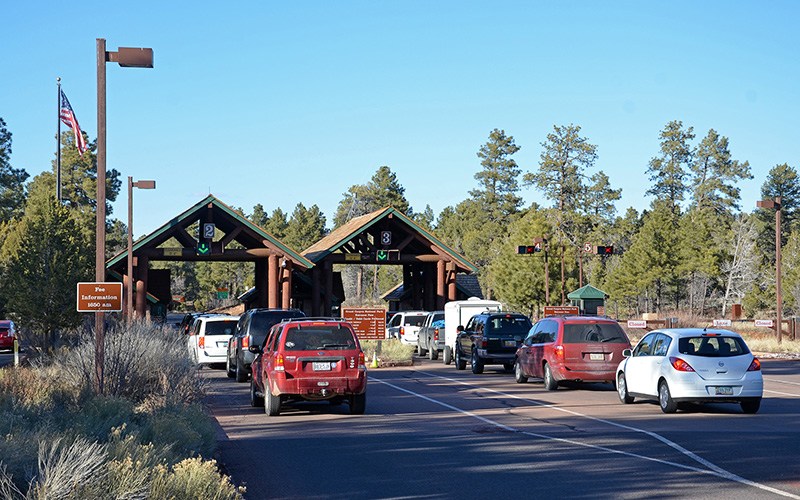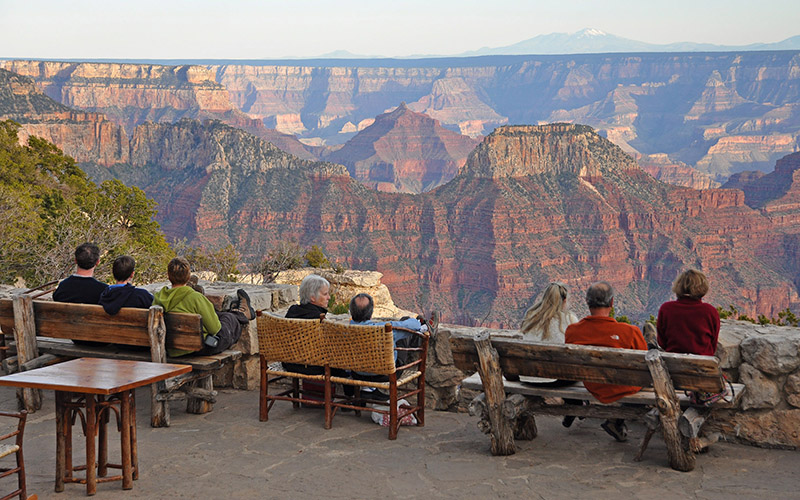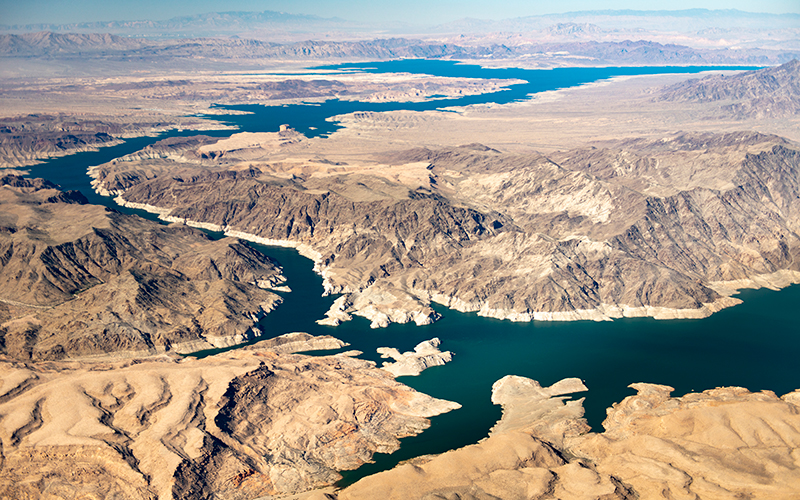
Cars line up to enter at the south entrance to the Grand Canyon in this 2018 file photo. After cratering during the pandemic, visits to national parks bounced back in 2021, not quite to pre-pandemic levels but high enough to give a significant boost to local economies. (Photo courtesy Grand Canyon National Park)
WASHINGTON – National parks in Arizona welcomed 10.7 million visitors who pumped $1.12 billion into local economies in 2021, both sharp increases from the pandemic-induced lows of the year before, according to the National Park Service.
While the numbers were still shy of their pre-pandemic levels, in the state and nationally, Arizona tourism officials were not complaining about the report for 2021.
“It’s a huge part of our city,” Flagstaff Mayor Paul Deasy said of national park tourism. “Small business is the backbone to most economies. And tourism is the way that our small businesses are able to survive and thrive.”
In Arizona, the number of visitors in 2021 was down from 12.5 million in 2019, when the amount spent by tourists was $1.3 billion. But both of the 2021 numbers were a vast improvement over the intervening year, when COVID-19 pushed visitors down to 7.6 million and spending on gas, lodging, food and more to $711 million.
That pattern was repeated at Grand Canyon National Park, which remained the state’s most popular national park. It saw visitors go from 5.9 million in 2019 to 2.9 million in 2020 before bouncing back to 4.5 million visitors last year.
But some parks in the region actually bested their pre-pandemic numbers in 2021. Visitors to Saguaro National Park spent $10 million more than they did in 2019, and Zion National Park in southern Utah saw spending rise by $409 million, a 158% increase over the same period. The number of visitors to Lake Mead in 2021 was 104,425 higher than in 2019.
That Grand Canyon did not match the surges posted by other parks in the region is “not concerning, at all,” said Brian Drapeaux, deputy superintendent for the Grand Canyon National Park.
“We don’t really look at how we compare visitations to other national parks,” he said. “Unlike many of the other large parks in the country, we’re a year-round park. A lot of the parks are seasonal parks, and so they’ll get crushed when they’re open.”
Drapeaux expects the number of visitors to rise this year as international travel returns to pre-pandemic norms. Financial services giant VISA said Grand Canyon was the most popular of the national parks for foreign tourists before the pandemic. But international tourism to the state fell by 76% in 2020, according to the Arizona Office of Tourism.
Considering the tight travel restrictions and health safety concerns, the 4.5 million Grand Canyon National Park visitors in 2021 are “still really amazing numbers,” Drapeaux said.
The NPS report said visitors to Grand Canyon National Park spent $710 million last year in local “gateway economies,” or communities near the park, up from $433 million in 2020.
Nationally, the number of visitors to national parks went from 327 million in 2019 to 237 million in 2020 before climbing back to 297 million last year. Spending over the same period went from $21 billion to $14.5 billion and then back to $20.5 billion.
The park service report ranked Arizona sixth among states for visitor spending and fifth for the total economic output from its national parks. It said Arizona’s 22 national park sites generated $1.8 billion in economic output and supported 16,074 jobs that paid $627.6 million in salaries.
Park visitors “support their nearby communities because they bring visitors there,” said Josh Coddington, director of communications at Arizona Office of Tourism.
“Visitors typically will stop and eat and buy gas and stay the night in different places in our communities across the state,” he said.

Tourism officials say Arizona’s natural wonders are likely to keep tourists coming to the state over time. (Photo by Michael Quinn/National Park Service)
The diverse landscape and natural wonders Arizona offers will continuously bring tourism dollars to the state, Coddington said.
“Certainly, the pandemic had a major impact on tourism everywhere, including in Arizona,” Coddington said. “As people started going out again, one of the places that was top on a lot of people’s minds to visit was outdoor places – state and national parks.”
With more tourists expected in coming years, Coddington said the focus will need to shift to managing what he called an anticipated national park tourism boom.
“These places and experiences, these amazing natural places that people have enjoyed for many, many years, how do we do it in a way that reduces the impact on that place?” Coddington asked. “It needs to be here for future generations to enjoy.”
It’s a sentiment Deasy also holds. His city is currently reeling from the Pipeline Fire, a wildfire that covered more than 26,000 acres.
“We welcome visitors. We want you to enjoy our natural environment,” Deasy said. “Let’s just make sure we’re being responsible and ensuring that we continue to protect that environment that we all love.”

